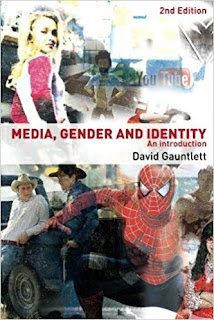David Gauntlett's theory
David Gauntlett: Media, Gender and Identity:
There is a huge amount we can take from Gauntlett's work across the mass media but these are three key ideas that we can apply to our Advertising and Marketing CSPs.
Idea 1: Identity is becoming more fluid
David Gauntlett writes that there is a “decline of tradition”.
“The mass media is a force for change… The traditional view of a woman as a housewife or low-status worker has been kick-boxed out of the picture by the feisty, successful 'girl power' icons. Meanwhile the masculine ideals of absolute toughness, stubborn self-reliance and emotional silence have been shaken by a new emphasis on men's emotions, need for advice, and the problems of masculinity.”
Gauntlett highlights the differences in views on identity between young and old – e.g. on homosexuality or masculinity.
“The mass media has become more liberal, and considerably more challenging to traditional standards… and this has been a reflection of changing attitudes, but also involves the media actively disseminating modern values.
Idea 3: Things change over time
Gauntlett talks positively about the media and audiences changing over time.
“Views of gender and sexuality, masculinity and femininity, identity and selfhood, are all in slow but steady processes of change and transformation.
“These things are not stationary. To discuss gender and media is to aim arguments at moving targets - which, again, is just as well.”
Gender, identity and advertising: blog tasks
David Gauntlett: academic reading
Read this extract from Media, Gender and Identity by David Gauntlett. This is another university-level piece of academic writing so it will be challenging - but there are some fascinating ideas here regarding the changing representation of men and women in the media.
1) What examples does Gauntlett provide of the "decline of tradition"?
1) What examples does Gauntlett provide of the "decline of tradition"?
- Gauntlett suggests a decline in traditional gender roles through examples like the portrayal of men doing domestic tasks in advertisements.
- He talks about instances where women are depicted as assertive and independent.
- Gauntlett highlights the use of humour and irony in advertising, challenging traditional norms and stereotypes.
Gauntlett suggests that the media influences the construction of our identities by providing a range of diverse representations and narratives that individuals can selectively choose to follow.
3) What does Gauntlett suggest regarding generational differences? Is it a good thing that the media seems to promote modern liberal values?
Gauntlett suggests that generational differences in media consumption contribute to changing attitudes, and while the promotion of modern values in media can change, it also requires understanding of societal issues.
4) Why does Gauntlett suggest that masculinity is NOT in crisis?
Gauntlett suggests that masculinity is not in crisis but rather undergoing a transformation, with diverse representations in media offering more inclusive and positive models for men to embrace.
5) Does advertising still reinforce the "conventionally rugged, super-independent, extra-strong macho man" that Gauntlett discusses? Offer examples for both sides of the argument from the wider advertising industry.
While some advertising still talks about the "macho man" stereotype, brands like Axe promoting hypermasculinity, others, like Gillette's "The Best Men Can Be" campaign, challenge these norms by advocating for more positive and inclusive expressions of masculinity.
6) Gauntlett discusses the idea of 'girl power' and offers examples from music and film. Does advertising provide evidence to support the idea of 'girl power' or is the industry still reinforcing traditional representations of men and women?
While some advertising campaigns, like Always' "Like a Girl," promote messages of empowerment for girls, the industry still often reinforces traditional gender representations, though there are shifts towards more diverse and empowering portrayals of women in recent years.
While younger generations may show more comfort with changing gender roles, advertising challenges some campaigns traditional gender norms while others, like Nike's "Dream Crazier," championing gender equality and female empowerment, reflecting a evolving landscape.
8) What examples from advertising does Gauntlett provide for the changing nature of gender in society (from the section on Judith Butler's Gender trouble)?
Gauntlett says people like Levi's "What Women Want" campaign, which challenges traditional gender roles by depicting women as assertive and empowered, as well as ads featuring differing models, such as those by Calvin Klein, which reflect shifts in societal understandings of gender.
Yes, I agree that the media plays a significant role in reinforcing changing attitudes towards gender and sexuality in society, as it reflects and shapes cultural norms.
Media Magazine: Andrew Tate - Masculinity in crisis?
Now read 'Tate Crime' - Media Magazine's analysis of the rise of online influencer Andrew Tate. You can find this in MM83 (p6) in our Media Magazine archive. Answer the following questions:
1) What is misogyny and how does it link to Andrew Tate?
Misogyny refers to the hatred, contempt, or prejudice against women, and Andrew Tate has faced criticism for his controversial statements and derogatory remarks about women on social media.
2) How does the article suggest Andrew Tate used social media to build up his reputation and following?
The article suggests that Andrew Tate used social media platforms such as Twitter and YouTube to share controversial opinions and lifestyle advice.
3) Does Andrew Tate's popularity suggest there is in fact a 'crisis in masculinity' - disagreeing with David Gauntlett's view?
Andrew Tate's popularity alone does not necessarily indicate a crisis in masculinity, as it could reflect his particular persona and content, rather than a widespread societal issue affecting all men, as Gauntlett's view suggests.

Comments
Post a Comment